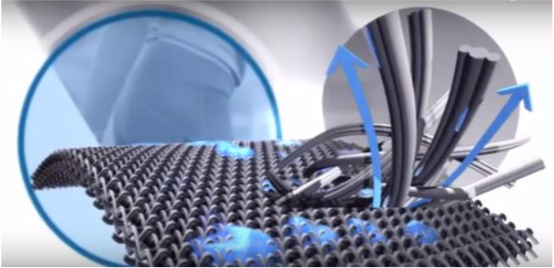Speciality fibers, made of polymers, carbon, glass or metals, are engineered for specific use and are able to respond to environmental conditions such as thermal, electrical, magnetic or mechanical and so on. High-performance fibers were invented several decades ago and are generally adopted in niche products for aerospace, defence, construction or protection. Besides focusing on apparel application, there is a global growing interest in technical textiles, and a wide range of industries continue to show interest in developing functional and intelligent textiles.
Carbon fibers differ in flexibility, electrical conductivity, thermal and chemical resistance with different production methods. Carbon fiber reinforced polymers have been widely used in aerospace, automotive, sports equipment and medical instruments. For the fashion industry, carbon filament yarns, fabrics can be used for protective or thermal-controlled clothes. In the coming years, further research would focus on productivity enhancement and cost reduction, and functional composites in 2D sheets and 3D components1.
There are many types of high-performance synthetic polymer fibers that are commonly used in different industries today2 . Polypropylene fibers, largely used in nonwoven fabrics, show high-resistance to chemicals, mildew, insects, perspiration, rot, stain and soil, are very lightweight, and have good washability, quick drying properties. Aramid fibers, one of the most representative commodities among the high-performance fiber family because of its high tenacity, high modulus, good heat and flame resistance, can be used for fire protective clothing and bulletproof vests and many other industrial reinforcement applications. Nylon or polyamide is another important man-made polymer for textiles, because of its properties of stiffness, toughness, lubricity, and resistance to temperature, fatigue, and abrasion. Nylon filaments can be used for high-modulus – high-tenacity fibers, flame retardant fibers, chemical resistance fibers and conductive fibers. Nylon-6 and nylon-66 are the most commonly used polyamides for technical fibers.
Nanofibers, with a diameter less than 1 µm, have attracted much attention in recent years because of their unique properties with functionalities from materials resulted in various novel properties and application. Among a number of preparation techniques, electrospinning is distinct from the others for its wide application of materials, ability to control nanofiber diameter, morphology and fibrous structure, ease of adding substances and possibility of bicomponent configuration, porous structure and nanotubes. Electrospun nanofibers have been used for innovative applications in the fields of biomedicine, energy and electronics, environmental protection, functional textiles; details are listed as follows:
Functional fabrics
Moisture management fabric is among the most popular of all functional fabrics. It generally has the properties of transferring sweat from skin to fabric surface with heat absorbing reaction, quick drying and good air permeability. The core technology for the Coolmax fabric is illustrated below3.
Using natural low-temperature mineral, cooling fabrics are designed to slow down the speed of fabric temperature from rising. Far infrared ray fibers can be used to keep warm as a thermal barrier, in which ceramic is built inside the fiber enabling body heat adsorption and the release of the far infrared ray4.
Biomedical applications
Tissue engineering scaffolds made by electrospun nanofibers are reported to mimic the native extracellular matrix so that functional compounds such as drugs can be encapsulated into the nanofibers. Biodegradable synthetic polymers such as polycaprolactone (PCL), polylactic acid (PLA), or naturally derived materials, including but not limited to collagen, chitosan and cellulose, have been selected to prepare scaffolds. Electrospun nanofibers can also be used for drug delivery in a controlled manner.
Energy and electronics applications
Intensive research has been conducted for the possibility of electrospun nanofibers for supercapacitors, batteries, sensors, solar cells etc.
Environmental protection applications
Electrospun nanofibers can be used for filtration and oil/water separation.
- http://www.fibersource.com/fiber-products/high-performance-fibers/ [3-06-2018]
- Bhat, Gajanan, ed. Structure and Properties of High-Performance Fibers. Woodhead Publishing, 2016.
- https://coolmax.com/en/About-the-COOLMAX-Brand/The-COOLMAX-brand [14-09-2018]
- http://textilecentre.blogspot.com/2014/04/far-infrared-rays-reflecting-fabrics.html [14-09-2018]

